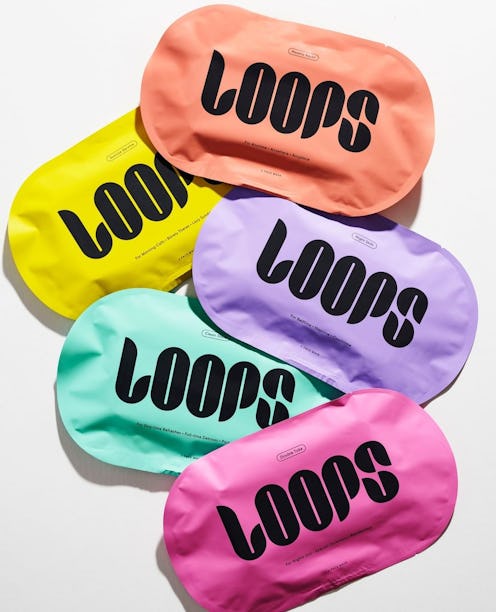Style
I Tried The Sheet Masks Celebrities Swear By While Social Distancing — Here's How They Work

Whether it's a pic of a holographic peel-off or one of vibrant, green clay, you probably have a row (or three) of mask selfies on your phone. We've all done it — and it turns out celebrities are no different: As stars practice social distancing, they're showing off their skin care routines, which for many includes Loops sheet masks.
The masks have been spotted on everyone from Gabrielle Union to Vanessa Hudgens, and with colorful packaging and an affordable price point, they're hard to miss despite just launching in February. But in a crowded skin care market, do they actually live up to the buzz?
Wait, What Are Loops Sheet Masks, And Why Are They So Special?
Sheet masks are usually made from fiber soaked in serum, but Loops are made from hydrogel. The material is created using polymers to give it a thick, film-like texture. While traditional masks are soaked, the ingredients are infused into hydrogels.
When it comes to those ingredients, the brand's mission is to keep it simple. Loops' masks have four key ingredients meant to impart benefits that target everything from brightness to hydration to antioxidant support.
What To Know About Loops' Application & Packaging
Loops comes in dual packaging. There's a plastic pouch with the brand's name in large letters on the front, and on the inside, you'll find a plastic tray that holds the masks. This keeps the hydrogel sheets contained and prevents serum from leaking all over the place.
If you've used a sheet mask, you know that reaching down into the packaging to retrieve the product can result in serum dripping down your hands, onto the countertop, and, well, basically everywhere. Thanks to Loops' packaging, that doesn't happen.
The hydrogel, however, does present a downside: It's sticky. The product comes in two pieces (a top and bottom) that are folded inside the tray and have a clear plastic backing. Once you unfold the mask, the hydrogel immediately starts folding, causing the pieces to suction together. The application then becomes a delicate balance of prying the mask apart while trying not to rip the hydrogel.
The instructions are pretty simple — apply and leave on for 10 minutes. Remember that stickiness from earlier? There's a reason it's not a deal breaker.
That same stickiness becomes one of Loops' greatest features. The masks do. Not. Budge. The hydrogel almost feels like it's suctioned to your face, and it doesn't drip, meaning you can enjoy that glass of wine without chasing it with a mouthful of serum.
OK, Do Loops Sheet Masks Actually Work?
My favorite Loops mask was Sunrise Service, which is meant to depuff, hydrate, brighten, and provide antioxidant support. According to the brand, it uses four ingredients — baobab oil, pumpkin extract, white flower extract, and Bio Duoferm — to do so.
Loops claims the baobab oil hydrates skin, and a 2017 study says the oil helps reduce trans-epidermal water loss while imparting moisture. I noticed a marked increase in hydration right after using the mask, and when I later applied my moisturizer, my skin seemed to retain the product longer than usual.
The mask also uses pumpkin extract, a commonly found ingredient in other brands. Sunrise Service claims it helps depuff and reduce signs of fatigue, although no studies directly link pumpkin with that ability. Still, I did notice that my skin appeared less puffy. The area under my eyes was noticeably smoother after wearing the mask, and my complexion looked calmer and less red overall.
The brand uses a white flower extract to "brighten and refresh." The extract is made from various flowers, including rose and lotus. Then, there's the Bio Duoferm, a probiotic combo meant to protect the skin from free radical damage.
Probiotics have been proven to help reduce inflammation and could help fight free radicals, and although you can't see your skin fighting off free radicals, my face didn't appear to have any redness or irritation after I removed the mask.
As for the floral extract, I can't say my skin appeared brighter. Although many of its components are good for the skin — like rose, with its anti-inflammatory benefits and lotus, which potentially can help combat oil — this is one ingredient you'd likely need to use over time to notice results.
Should You Try Loops Sheet Masks?
The results were good, if not pretty standard. All five masks I tested gave me added hydration and a calm complexion. And, as with any other claims (like anti-aging benefits or antioxidant support), there's just no way to know how well they hold up — at least not without repeated, long-term use. But if you love trying new sheet masks, Loops is definitely a fun, new option to try.
Sources:
Komane, B., Vermaak, I., Kamatou, G., Summers, B., Viljoen, A. (2017). Beauty in Baobab: a pilot study of the safety and efficacy of Adansonia digitata seed oil. Revista Brasileira de Farmacognosia. https://www.sciencedirect.com/science/article/pii/S0102695X16300874
Bardaa, S., Halima, N., Aloui, F., Mansour, R., Jabeur, H., Bouaziz, M., Sahnoun, S. (2016). Oil from pumpkin (Cucurbita pepo L.) seeds: evaluation of its functional properties on wound healing in rats. Lipids in Health and Disease. https://www.ncbi.nlm.nih.gov/pmc/articles/PMC4827242/
Yu, Y., Dunaway, S., Champer, J., Kim, J., Alikhan, A. (2020). Changing our microbiome: probiotics in dermatology. The British Journal of Dermatology. https://www.ncbi.nlm.nih.gov/pubmed/31049923
Lee, M., Nam, T., Lee, I., Shin, E. Han, A., Lee, P., Lee, S., Lim, T. (2018). Skin anti‐inflammatory activity of rose petal extract (Rosa gallica) through reduction of MAPK signaling pathway. Food Science and Nutrition. https://www.ncbi.nlm.nih.gov/pmc/articles/PMC6261181/
Mahmood, T., Akhtar, N., Moldovan, C. (2013). A comparison of the effects of topical green tea and lotus on facial sebum control in healthy humans. Hippokratia Quarterly Medical Journal. https://www.ncbi.nlm.nih.gov/pmc/articles/PMC3738281/